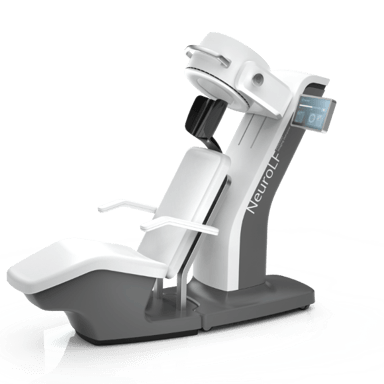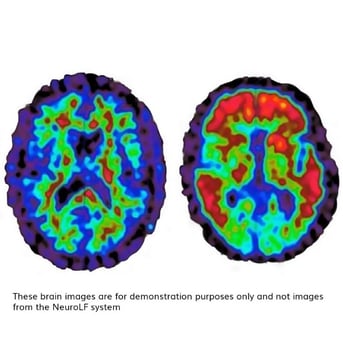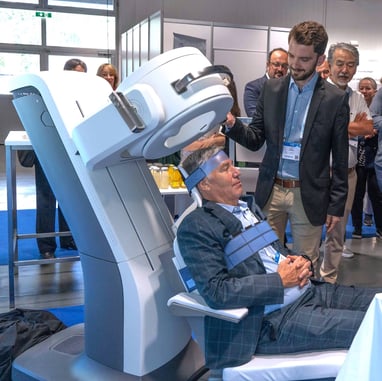In medical imaging, we usually take our devices for granted - unless they don't work. We know that the technology behind them is highly developed. But how are they built? Who are the people whose design determines our workflows? How do they build the machines that determine the quality of our imaging? Sometimes we admire their machines, sometimes we despair at their flaws, but their design determines our everyday lives.
Positrigo is at the forefront of the medical revolution with their groundbreaking product, the NeuroLF System. This ultra-compact brain positron emission tomography system (brain PET for short) opens up new horizons in precision medicine, bringing functional imaging within reach of people all over the world.
By using NeuroLF, functional brain imaging becomes not only powerful but also cost-effective. This advanced technology is particularly valuable in the early detection and diagnosis of dementia, including Alzheimer's disease, and offers new opportunities to study a wide range of brain disorders. Positrigo is backed by a dynamic team of talented engineers in mechanics, electronics and software, complemented by experienced scientific and commercial staff.

A PET System in seated position
As with many imaging modalities, patient positioning is a central component for image quality, comfort and hygiene in this new brain PET system. To this end, Positrigio decided to work with Pearl Technology AG as a preferred partner to develop a holistic positioning concept in line with the latest standards.
After the successful development and launch of the NeuroLF at the EANM in Vienna in September 2023 and many years of collaboration, I am sitting together with Dr. Stefan Bircher, Chief Commercial Officer of Positrigo...
Dear Stefan, could you introduce yourself?
My name is Stefan Bircher, I am the so-called CCO - Chief Commercial Officer and in this role I have a strong focus on the customer side. I've been with Positrigo for almost three years and take care of everything relating to market development, sales system development and sales. We are an ETH spin-off that was founded in 2018 and have been operational since 2020 - almost four years now! We are developing a dedicated brain PET system - with the aim of detecting brain diseases at an early stage. The focus is currently on Alzheimer's diagnostics, but we are also moving in the direction of oncology, epilepsy and Parkinson's, all of which can also be diagnosed using PET.

Stefan Bircher, the Chief Commercial Officer of Positrigo
How did it come about that you developed NeuroLF? And what is your current status?
Positrigo was founded by several students and professors at ETH (Swiss Federal Institute of Technology in Zurich) - but the main founders are Max Ahnen and Jannis Fischer. As physicists, they did their doctoral thesis and postdoc in the same lab, where they developed a new PET scanner: a particularly small version for use on small animals. This gave rise to an idea: if this technology works for animals, could it also be developed for human organs such as the brain? This original idea came from Professor Alfred Buck, who was the director of the Neuro-PET program at the USZ (University Hospital Zurich) at the time and realized that if more and more brain diseases are to be diagnosed, and if more and more modern therapies become available, the need for brain scans will increase significantly. Therefore, it is inefficient to use large, expensive devices, but it would be better if there were small, specific and perhaps cheaper devices. After a good three years of development, we are now close to approval, which means that development will soon be complete and we expect to obtain FDA approval in the USA and the CE mark for sale in Europe next year.

That's something to celebrate, congratulations! Another question: how do you position the patients?
The device looks a bit like a hairdresser's hood, in which the patient sits rather than lies. Patients are very much in favor of this, as they can look out into the room and are not lying in a narrow tube. However, sitting means that patients can move around more easily. They can slip more easily, slump a little or move their head. In order to rule out such so-called "motion artifacts", it is important to position patients well. I deliberately don't say "fixate" - rather, we stabilize patients. We work together with you - Pearl Technology - to stabilize both the thighs and the head with straps. These straps have to be comfortable for the patient and still stabilize well enough to prevent movement artifacts.
→ Further information on the use case of patient positioning for brain PET in a sitting position at the end of the interview.

The blue ProBelts for positioning patients - here at a demonstration at the EANM in Vienna
How did you come across a manufacturer like us?
Pearl Technology was already known to us as an expert in the radiology world - and as a Swiss company and ETH spin-off, we were able to find the necessary trust. We had originally considered developing something like this ourselves, but quickly realized that it is much easier to obtain the knowledge of materials science and patient needs from you as a reliable partner. Over the past few years, we have experienced how you maintain your service level and also know how to organize such a collaboration efficiently and successfully. We have greatly appreciated the very smooth and uncomplicated cooperation.
How do you look after your customer experience?
This is very important. On the one hand, we primarily have the nuclear medicine specialist who wants to get a good picture of the brain. That's the be-all and end-all, because nuclear medicine specialists are the decision-makers who need to be convinced of our product. On the other hand, it is also nice to hear that patients find the sitting position comfortable, for example, and therefore prefer to be examined on our device. A high level of patient satisfaction is one of many unique selling propositions. Whenever possible, we want to offer patients a pleasant experience.
Thank you! Is there anything else you would like to say?
Basically, we very often work with other companies because we can't or don't want to develop some areas ourselves. It's always great when there are companies like you where you can work out a joint solution in a very uncomplicated way - be it in marketing or in terms of the end product.
Of course we are pleased to hear that. For us, it's just as much a pleasure to be involved with state-of-the-art devices and to make our contribution.
USE CASE: SOLUTIONS FOR HOLISTIC PATIENT POSITIONING DURING SEATED BRAIN-PET EXAMINATIONS
AN AMBITIOUS PROJECT FROM THE START
The aim of the collaboration was to develop a holistic concept for patient positioning using the latest technology to support...
- Excellent image quality (reduced movement artifacts, materials without impact on image quality)
- Optimal patient experience (comfort, safety)
- Great ease of use (simple, fast, repeatable)
The project started at an early stage, long before the first PET scanner prototype was developed. At that time, many fundamental design questions about the scanner were still open, which presented both challenges and opportunities for finding specific solutions for patient positioning.
The following aspects in particular had to be taken into account during development:
- High image resolution required effective motion suppression in the sub-millimeter range
- Sitting position of the patient with a planned examination duration of 15 - 20 minutes
- Tight space conditions and difficult access to patients within the "hood" (diameter of 26 cm)
- Patient clientele: mainly Alzheimer's patients who may have a limited tolerance to immobilization aids and have difficulty sitting still during the examination
Collaborative innovation: a proactive and iterative development process
In order to overcome these challenges, an early exchange of ideas took place, which led to the creation of a catalog of requirements for patient positioning. This process also included a hands-on positioning workshop on the PET scanner prototype for a comprehensive assessment of different materials and solutions. By developing and implementing selected concepts as functional models and several feedback and prototype iterations, an effective solution was found.
THE END RESULT: A CUSTOMIZED Positioning KIT
The resulting positioning kit includes a ProFoam stability insert in the carbon shell, ProBelts for the head, upper body and legs and a PearlFit support cushion. The choice of materials is particularly noteworthy: for direct patient contact, only hard-wearing PU film is used, which is processed using a high-frequency welding process. This means that the solutions meet today's hygiene requirements and offer a reliable solution even with high patient throughput.
In addition to pure development work, Pearl Technology is responsible for manufacturing the products, including labeling and packaging, as well as meeting regulatory requirements in the EU and USA. As the legal manufacturer of these Class 1 medical devices, compliance with all essential laws, norms and standards, such as EU MDR 2017/745 and EC/1907/2006 REACH, is ensured.
